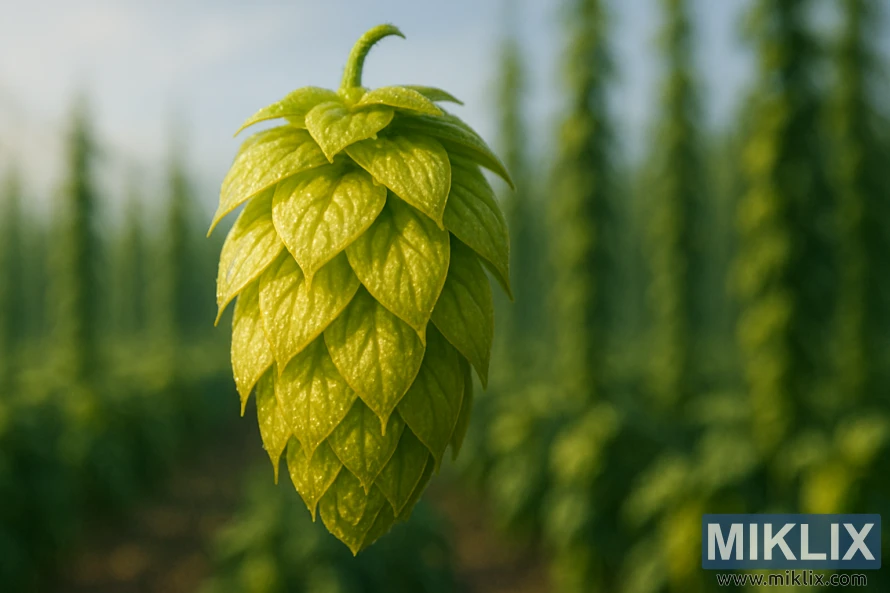Image: California Cluster Hop Cone
Published: August 14, 2025 at 6:47:23 AM UTC
Last updated: September 26, 2025 at 8:39:54 PM UTC
Detailed close-up of a California Cluster hop cone with lupulin glands, set against blurred hop bines, highlighting its aroma and flavor in craft beer brewing.
The photograph draws immediate focus to a single hop cone, suspended in the foreground with striking clarity against the soft blur of a hop field beyond. Bathed in natural light, the cone’s golden-green bracts overlap in flawless symmetry, their pointed tips tapering gently downward in a natural spiral that seems both elegant and functional. Each scale appears almost translucent under the sun’s glow, the fine textures of veins and edges revealed with precision. The cone is vibrant, fresh, and alive with promise, embodying the essence of the California Cluster variety, a hop that carries both historical weight and enduring relevance in brewing.
At this distance, the details feel intimate, almost microscopic in effect. One can imagine the presence of the tiny lupulin glands nestled deep within the folds of the cone—resinous, golden-yellow sacs that contain the oils and acids responsible for defining bitterness, aroma, and flavor. Though hidden from direct view, their importance is palpable. These glands hold the compounds that, when boiled in wort, lend bitterness to balance malt sweetness, or when added later in the process, release volatile oils that imbue beer with complex aromas. The surface glistens faintly, suggesting freshness and the potential stickiness of those resins, as though the cone itself is eager to share the chemistry it contains.
The blurred background provides context without distraction. Tall, vertical bines rise in orderly rows, reaching skyward along their trellises. Their repetition forms a rhythmic pattern softened by distance, a sea of green pillars swaying lightly in the breeze. This gentle motion, though unseen, is implied by the relaxed tilt of leaves and the warmth of sunlight diffused through the field. Together, they root the cone in its natural environment, reminding the viewer that while this close-up isolates one specimen, it is part of a much larger tapestry of cultivation and growth.
The lighting enhances the mood and purpose of the composition. The golden rays of the sun illuminate the cone’s bracts, turning them into overlapping layers of light and shadow. Subtle gradients run across each surface, shifting from lime green highlights to deeper olive tones in the recesses. The interplay of illumination and shadow highlights the natural geometry of the cone, transforming it into both a botanical specimen and a work of art. The effect is clean, crisp, and purposeful, echoing the clarity of scientific observation while retaining the organic warmth of nature.
This duality—scientific and artistic, practical and aesthetic—echoes the role of hops in brewing. To a brewer, a hop cone is not just a plant but a reservoir of possibilities, capable of shaping the identity of a beer. California Cluster hops in particular are known for their balance of earthy, floral, and subtly fruity notes, a flavor profile that reflects both tradition and versatility. This image captures that dual nature: the hop as an object of study and as a symbol of creativity, a reminder that the artistry of brewing begins with close attention to details such as these.
Ultimately, the composition elevates the hop cone from a mere agricultural product to a protagonist in the story of beer. By isolating it against its blurred yet abundant background, the photograph suggests that while entire fields contribute to the harvest, each individual cone carries within it the potential to transform a brew. In its intricate design and hidden chemistry lies the very heart of craft brewing, a testament to the enduring connection between field, science, and the sensory experience of the final pint.
The image is related to: Hops in Beer Brewing: California Cluster

